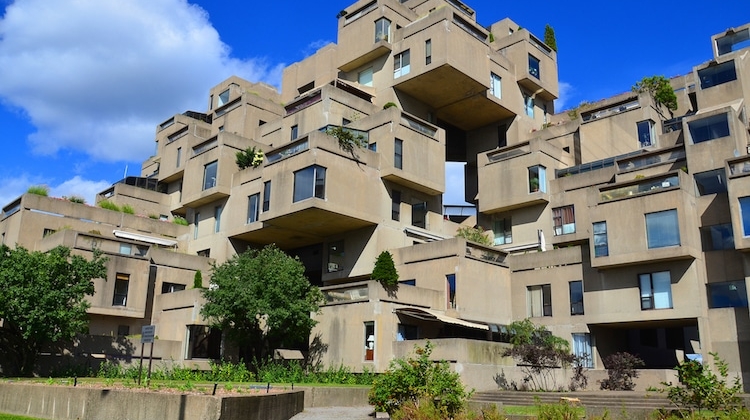Must Architecture Be Ugly?
It wasn’t always this way.

|
Getting your Trinity Audio player ready...
|
[Want even more content from FPM? Sign up for FPM+ to unlock exclusive series, virtual town-halls with our authors, and more—now for just $3.99/month. Click here to sign up.]
Nowadays, most public buildings are constructed in the brutalist style, and they are just that: a determinedly ugly assault on the eyes. President Trump tried to push back against this during his first term, only for Old Joe Biden to reverse this immediately upon taking office. The left wants our landscape to be ugly. But it wasn’t always this way.
The sixth-century Roman Emperor Justinian’s greatest achievement, Hagia Sophia, was not only a beautiful public building. It stood for nearly a millennium not only as the largest and grandest church in the Christian world, and so it is no surprise that it was widely imitated, and not just in the architecture of Orthodox churches throughout the world. Saint Mark’s Basilica in Venice bears numerous points of resemblance to Hagia Sophia and is filled with icons and other sacred objects taken from Constantinople by the crusaders in 1204. The Dome of the Rock on the Temple Mount in Jerusalem, built in 691, is also largely patterned after Hagia Sophia, as is the Umayyad Mosque in Damascus, the Suleyman Pasha Mosque in Cairo, and several mosques in present-day Istanbul itself. Even the nineteenth-century Great Synagogue of Florence sports a dome that shows signs of Hagia Sophia’s influence.
Hagia Sophia itself remains as potent a symbol fifteen hundred years after its construction as it was on the day it was consecrated. What exactly it symbolizes, however, has shifted throughout history. Justinian intended it to show forth the truth and triumph of Christianity and the grandeur of his empire. Similarly, when the Sultan Mehmed summoned a muezzin and had him proclaim the shahada, the Islamic profession of faith, in the conquered church on May 29, 1453, as the blood of Christians he and his men had just slaughtered ran in the aisles, he intended the newly converted mosque to stand as a symbol of the triumph of Islam over Christianity and the superiority of the religion of Muhammad over that of Christ.
Nearly five hundred years later, in 1935, the founder of secular Turkey, Mustafa Kemal Ataturk, also eyed the great building for its symbolic value. He converted the “Aya Sofya mosque” (the name of the Cathedral of Holy Wisdom being carried over into a new language and new religion in which it became just that, a name, bereft of meaning) into a museum, intending it to demonstrate the triumph of secularism and rationalism over religious superstitions both Christian and Islamic, particularly Islamic. “Islam,” said Ataturk, “this theology of an immoral Arab, is a dead thing.” His museum was meant to demonstrate that all that religious mumbo-jumbo was a dead thing, now laid out and preserved and displayed in what once had been the greatest manifestation of Christian religiosity in the entire world.
Then in 2020, when Erdogan dismayed the world by converting Hagia Sophia into a functioning mosque once again, he also had an eye upon the building’s symbolic value. Erdogan had spent nearly two decades as secular Turkey’s prime minister and then its president systematically dismantling Kemalist secularism, building Islamic schools and mosques at a rapid clip, restoring a strong Islamic component to Turkish education, repeatedly railing against secularism, and even uttering revanchist statements about Turkey being the rightful owner of the lands that had at one time or another suffered under Ottoman rule. Erdogan’s restoration of “Aya Sofya” as a mosque epitomized his entire program of the restoration of Islam as the centerpiece of Turkish society. What was old had become new again. Erdogan’s reconversion of the building was enormously popular among Turks, who thronged to be among those to be the first to pray once again in the newly re-Islamized structure, the glorious icons that had been uncovered during the restoration of the museum being newly covered again for Islamic prayer. Erdogan intended the restored mosque to symbolize Islam’s new triumph over secularism as well as its old one over Christianity, and his message resonated with a large segment of his people.
Justinian would have been disgusted at the desecration of the cathedral into which he had invested so much, and not just money. But he would have understood the symbolism.
Even as modern-day Istanbul has far exceeded the boundaries of Constantinople at its height, Hagia Sophia is still a commanding presence in the city, and one that defines its aesthetic. Justinian intended the beauty and magnificence of the structure to be an integral part of his plan to make Constantinople the greatest city in the world and the capital not just of the empire but of the civilized world itself. As such, it was of supreme importance that Hagia Sophia not be an eyesore or at odds with the landscape in which it was placed. The breathtaking beauty of the building was considered a reflection of the beauty of the heavenly realms and of God himself. The Orthodox liturgy that was celebrated inside the completed Hagia Sophia was likewise always infused with a strong sense that its beauty reflected the truths of salvation and thus was integral to the presentation.
Nowadays, as is so often the case, we know better. Large-scale public buildings are often constructed according to the architectural and philosophical dictates of brutalism, which demands that structures be ruthlessly utilitarian. Satisfying the human desire for beauty, and for architecture that exalts the spirit and imbues one with a sense of grandeur, however, is not considered useful in this scenario. Brutalist structures are often straight boxes, bereft entirely of anything upon which the eye can rest, much less feast. In keeping with their name, many seem to be deliberately offensive, with jutting angles and uneven lines that seem deliberately designed to render one disoriented and off-balance. Even many churches seem to compete with one another in ugliness. Were a modern-day Justinian to build a Hagia Sophia today, it is certain that the result would differ radically from what Justinian’s architects and builders constructed, not just because our world is so very different from sixth-century Constantinople, or because the faith that imbued that structure has largely vanished from human societies, but because the prevailing philosophy of architecture today has no patience for structures of that kind. The new cathedral, or whatever it would be, would be a monstrosity of steel, glass, and geometric oddities.
Some object today to brutalist architecture over its demonstration of contempt for the people who will use such buildings and for the surrounding landscape as well. Justinian, by contrast, understood the power of beauty and of grandeur, and the solace that they offered to the human spirit. Many people today are far too sophisticated for all that.

